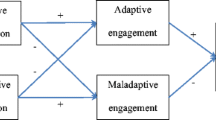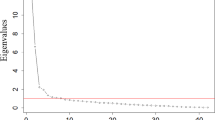Abstract
Using multilevel models, this study examined whether the strength of the association between student engagement and development of generic student competencies (GSCs) varies across Korean colleges. Data from the Korean Educational Development Institute’s 2007 national sample and from 5,445 students representing 60 four-year colleges and universities were utilized. The results indicate that a specific type of engagement is linked to a particular learning outcome, which means that not every engagement type has an equal impact thereon. The findings also suggest that in Korea, the impact on GSC of one of the student engagement types, that is, active learning, significantly varies by college mission and the peer climate of cooperative learning.


Similar content being viewed by others
Notes
For policy purposes, the Korean Ministry of Education developed a classification scheme for four-year colleges and universities in 2005. It identified eight institutional groups according to two dimensions: “specialized area of education” and “institutional type.” The former dimension is based on the number of students enrolled in particular academic disciplines (comprehensive and limited), and the latter on enrollment profile, the scale of government funding, and research achievements.
References
Allison, P. D. (2002). Missing data. Thousand Oaks, CA: Sage Publications.
Altbach, P. G., Reisberg, L., & Rumbley, L. E. (2009). Trends in global higher education: Tracking an academic revolution. Paris: UNESCO.
Astin, A. W. (1984). Student involvement: A developmental theory for higher education. Journal of College Student Personnel, 25, 297–308.
Astin, A. W. (1993). What matters in college? Four critical years revisited. San Francisco: Jossey-Bass.
Berger, J. B., & Milem, J. F. (2000). Organizational behavior in higher education and student outcomes. In J. C. Smart (Ed.), Higher education: Handbook of theory and research (Vol. XV, pp. 268–338). New York: Agathon Press.
Billing, D. (2003). Generic cognitive abilities in higher education: And international analysis of skills sought by stakeholders. Compare, 33(3), 335–350.
Bourdieu, P. (1984). Distinction: A social critique of the judgement of taste. London: Routledge.
Carini, R. M., Kuh, G. D., & Klein, S. P. (2006). Student engagement and student learning: Testing the linkages. Research in Higher Education, 47(1), 1–32.
Choi, J., & Rhee, B. S. (2009). Examining factors related to college students’ learning outcomes: Focusing effects of college. The Journal of Educational Administration, 27(1), 199–222.
Davis, T. M., & Murrell, P. H. (1990). Joint factor analysis of the College Student Experiences Questionnaire and the ACT COMP objective exam. Research in Higher Education, 31, 425–442.
Demerouti, E., Bakker, A. B., Nachreiner, F., & Schaufeli, W. B. (2001). The job demands-resources model of burnout. Journal of Applied Psychology, 86, 499–512.
Flowers, L., Osterlind, S. J., Pascarella, E. T., & Pierson, C. T. (2001). How much do students learn in college? Cross-sectional estimates using the college BASE. The Journal of Higher Education, 72, 565–583.
Gellin, A. (2003). The effect of undergraduate student involvement on critical thinking: A meta-analysis of the literature 1991–2000. Journal of College Student Development, 44, 746–762.
Gonyea, R. M. (2005). The relationship between student engagement and selected desirable undergraduate outcomes in the first year of college. Bloomington, IN: Indiana University.
Heck, R. H., & Thomas, S. L. (2008). An introduction to multilevel modeling techniques. New York, NY: Routledge.
Hu, S., & Kuh, G. D. (2001). Being (dis)engaged in educationally purposeful activities: The influences of student and institutional characteristics. Research in Higher Education, 43(5), 555–575.
Hurtado, S., Milen, J. F., Claytonn-Pedersen, A., & Allen, W. R. (1999). Enacting diverse learning environments. Improving the climate for racial/ethnic diversity in higher education. Washington, DC: George Washington University Press.
Kim, E. (2010). The characteristics and experiences of first-generation college students. The Korea Educational Review, 16(2), 103–123.
Kim, A., & Rhee, B. (2003). An analytic study of identifying personal and institutional influences on the perceived development of core competencies of college students. The Journal of Korean Education, 30(1), 367–392.
Ko, J. W., Kim, H. J., & Kim, M. S. (2011). Cognitive and non-cognitive outcomes, and instructional satisfaction. The Journal of Educational Administration, 29(4), 169–194.
Kuh, G. D. (1993). In their own words: What students learn outside the classroom. American Educational Research Journal, 30(2), 277–304.
Kuh, G. D. (1995). The other curriculum: Out-of-class experiences associated with student learning and personal development. Journal of Higher Education, 66, 123–155.
Kuh, G. D. (2001). Assessing what really matters to student learning: Inside the national survey of student engagement. Change, 33(3), 10–17, 66.
Kuh, G. D., & Hu, S. (2001). Learning productivity at research universities. Journal of Higher Education, 72(1), 1–28.
Kuh, G. D., Kinzie, J., Buckley, J. A., Bridges, B. K., & Hayek, J. C. (2006). What matters to student success: A review of the literature. Commissioned report for the national symposium on postsecondary student success: Spearheading a dialogue on student success.
Lamport, M. A. (1993). Student-faculty interaction and the effect on college student outcomes: A review of the literature. Adolescence, 28, 971–990.
Maslach, C., & Leiter, M. P. (1997). The truth about burnout. San Francisco, CA: Jossey Bass.
McCormick, A. C., Pike, G. R., Kuh, G. D., & Chen, P. D. (2009). Comparing the utility of the 2000 and 2005 Carnegie classification systems in research on students’ college experiences and outcomes. Research of Higher Education. doi:10.1007/s11162-008-9112-9.
Nusche, D. (2008). Assessment of learning outcomes in higher education: A comparative review of selected practices. OECD Education Working Paper, No. 15. Paris: OECD.
OECD (2012). The rational for an AHELO: Higher education in the 21st century.
Osegura, L., & Rhee, B. (2009). The influence of institutional retention climates on student persistence to degree completion: A multilevel approach. Research in Higher Education, 50(6), 546–569.
Pace, C. R. (1984). Measuring the quality of college student experiences. An account of the development and use of the college student experiences questionnaire. Los Angeles: Higher Education Research Institute.
Pascarella, E. T. (2001). Identifying excellence in undergraduate education: Are we even close? Change, 33(1), 18–23.
Pascarella, E. T., & Terenzini, P. T. (2005). How college affects students: A third decade of research. San Francisco: Jossey-Bass.
Pike, G. R. (1995). The relationship between self reports of college experiences and achievement test scores. Research in Higher Education, 36, 1–21.
Pike, G. R., & Kuh, G. D. (2005a). A typology of student engagement for American college and universities. Research in Higher Education, 46(2), 185–209.
Pike, G. R., & Kuh, G. D. (2005b). First- and second-generation college students: A comparison of their engagement and intellectual development. Journal of Higher Education, 76(3), 276–286.
Pike, G. R., Kuh, G. D., & Gonyea, R. M. (2003). The relationship between institutional mission and students’ involvement and educational outcomes. Research in Higher Education, 44(2), 241–261.
Podsakoff, P. M., & Organ, D. W. (1986). Self-reports in organizational research: Problems and prospect. Journal of Management, 12(4), 531–544.
Porter, S. R. (2006). Institutional structures and student engagement. Research in Higher Education, 47, 521–558.
Raudenbush, S. W., & Bryk, A. S. (2002). Hierarchical linear models. Newbury Park, CA: Stage.
Rhee, B. S., & Choi, J. (2008). Analyzing influences on the perceived development of core competencies of college students: a multilevel approach. The Journal of Korean Education, 35(2), 243–266.
Rhee, B. S., Kim, H. R., Gong, H. J., Park, H. K., & Jhun, M. K. (2012). Studying college impact in Korea: Recent trends and issues. Ewha Journal of Educational Research, 43(4), 191–219.
Schaufeli, W. B., Martinez, I. M., Pinto, A. M., Salanova, M., & Bakker, A. B. (2002a). Burnout and engagement in university students: A cross-national study. Journal of Cross-Cultural Psychology, 33(5), 464–481.
Schaufeli, W. B., & Salanova, M. (2007). Efficacy or inefficacy, that’s the question: burnout and work engagement, and their relationship with efficacy beliefs. Anxiety, Stress, and Coping, doi:10.1080/10615800701217878.
Schaufeli, W. B., Salanova, M., Gonzales-Roma, V., & Bakker, A. B. (2002). The measurement of engagement and burnout: A two sample confirmatory factor analytic approach. Journal of Happiness Studies. doi:10.1023/A:101563093026.
Seligman, M. E. P., & Csikszentmihalyi, M. (2000). Positive psychology: An introduction. American Psychologist, 55, 5–14.
Seo, M. (2003). The logic of hierarchical linear model and its application: An analysis of the effects of university education on students. Journal of Educational Evaluation, 16(2), 43–63.
Shin, J., & Harman, G. (2009). New challenges for higher education: Asia-Pacific and global perspectives. Asia Pacific Education Review, 10(1), 1–13.
Tinto, V. (1993). Leaving college: Rethinking the causes and curse of student attrition. Chicago: The University of Chicago Press.
Titus, M. A. (2004). An examination of the influence of institutional context on persistence at 4-year college and universities: A multilevel approach. Research in Higher Education, 45(7), 673–699.
Toutkoushian, R. K., & Smart, J. C. (2001). Do institutional characteristics affect student gains from college? Review of Higher Education, 25, 39–61.
Yu, H. S., Ko, J. W., & Lim, H. N. (2011). Examining learning experiences influencing on the communication skills and high-order thinking skills. The Journal of Educational Administration, 29(4), 319–337.
Zhao, C., & Kuh, G. D. (2004). Adding value: Learning communities and student engagement. Research in Higher Education, 45, 115–138.
Author information
Authors and Affiliations
Corresponding author
Rights and permissions
About this article
Cite this article
Choi, B.K., Rhee, B.S. The influences of student engagement, institutional mission, and cooperative learning climate on the generic competency development of Korean undergraduate students. High Educ 67, 1–18 (2014). https://doi.org/10.1007/s10734-013-9637-5
Published:
Issue Date:
DOI: https://doi.org/10.1007/s10734-013-9637-5




